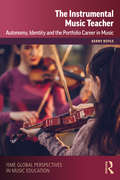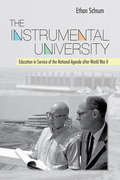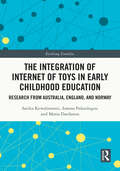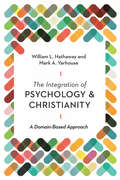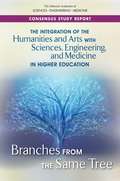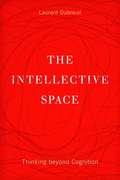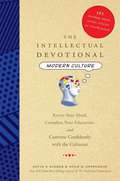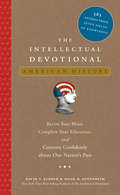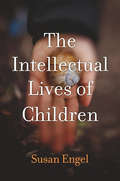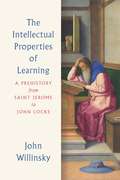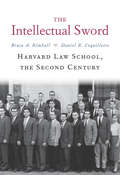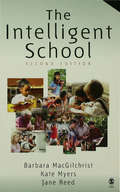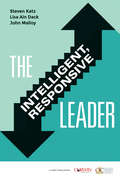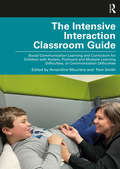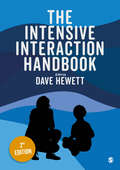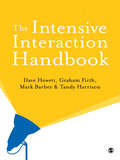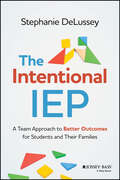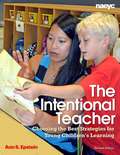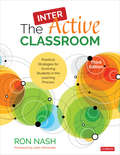- Table View
- List View
The Instrumental Music Teacher: Autonomy, Identity and the Portfolio Career in Music (ISME Series in Music Education)
by Kerry Boyle International Society for Music Education (ISME)Instrumental teaching in the UK is characterised by a lack of regulation and curriculum, whereby individuals can teach with no training or qualification. Kerry Boyle explores the way in which individuals who begin teaching can negotiate successful careers in music without formal training. Existing studies suggest that individuals in this context have complex understandings of professional identity, preferring to identify as musicians or performers rather than teachers, even when most of their income is derived from teaching. Boyle explores the complex working lives of instrumental teachers in the UK, including routes into instrumental teaching and the specific meanings associated with the role and identity of the professional musician for individuals involved in portfolio careers in music. Through an examination of the lived experience of instrumental teachers, this study highlights the need to revise existing notions of the professional musician to acknowledge contemporary careers in music. The resulting insights can be used to inform and enhance existing approaches to careers in music and contribute to career preparation in undergraduate music students.
The Instrumental University: Education in Service of the National Agenda after World War II (Histories of American Education)
by Ethan SchrumIn The Instrumental University, Ethan Schrum provides an illuminating genealogy of the educational environment in which administrators, professors, and students live and work today. After World War II, research universities in the United States underwent a profound mission change. The Instrumental University combines intellectual, institutional, and political history to reinterpret postwar American life through the changes in higher education. Acknowledging but rejecting the prevailing conception of the Cold War university largely dedicated to supporting national security, Schrum provides a more complete and contextualized account of the American research university between 1945 and 1970. Uncovering a pervasive instrumental understanding of higher education during that era, The Instrumental University shows that universities framed their mission around solving social problems and promoting economic development as central institutions in what would soon be called the knowledge economy. In so doing, these institutions took on more capitalistic and managerial tendencies and, as a result, marginalized founding ideals, such as pursuit of knowledge in academic disciplines and freedom of individual investigators.The technocratic turn eroded some practices that made the American university special. Yet, as Schrum suggests, the instrumental university was not yet the neoliberal university of the 1970s and onwards in which market considerations trumped all others. University of California president Clark Kerr and other innovators in higher education were driven by a progressive impulse that drew on an earlier tradition grounded in a concern for the common good and social welfare.
The Integration of Internet of Toys in Early Childhood Education: Research from Australia, England, and Norway (Evolving Families)
by Ioanna Palaiologou Sarika Kewalramani Maria DardanouThis book offers a fresh look at recent developments in policy, curricula and pedagogical discourse around children’s play with Internet of Toys (IoToys). By expanding the notion of digital and smart play perspectives in early childhood education, the authors critique and develop the broader subject area of IoToys play to better serve its end users. The book brings together research from across three different countries: Australia, Norway and England. It offers tangible examples of how one can use IoToys to build children’s social skills, emotional intelligence, sense of achievement, collaboration and aspects of STEM and design play thinking processes. The learning stories of children’s IoToys play will deliver a comprehensive review of how practitioners and parents can come together to build communities of practice for (re)enhancing children’s learning and growth using evolving technology-based play and engage in paradigmatic debates. Readers as a result will better appreciate the growth in pragmatic applications of technologies together with theoretical perspectives. The book will be a valuable resource for any academic or practitioner just beginning to understand the complexities and success stories of integrating IoToys for children’s playful learning.
The Integration of Psychology and Christianity: A Domain-Based Approach (Christian Association for Psychological Studies Books)
by Mark A. Yarhouse William L. Hathawayworldview integrationtheoretical integrationapplied integrationrole integrationpersonal integration
The Integration of the Humanities and Arts with Sciences, Engineering, and Medicine in Higher Education: Branches From The Same Tree
by Engineering Medicine National Academies of SciencesIn the United States, broad study in an array of different disciplines —arts, humanities, science, mathematics, engineering— as well as an in-depth study within a special area of interest, have been defining characteristics of a higher education. But over time, in-depth study in a major discipline has come to dominate the curricula at many institutions. This evolution of the curriculum has been driven, in part, by increasing specialization in the academic disciplines. There is little doubt that disciplinary specialization has helped produce many of the achievement of the past century. Researchers in all academic disciplines have been able to delve more deeply into their areas of expertise, grappling with ever more specialized and fundamental problems. Yet today, many leaders, scholars, parents, and students are asking whether higher education has moved too far from its integrative tradition towards an approach heavily rooted in disciplinary “silos”. These “silos” represent what many see as an artificial separation of academic disciplines. This study reflects a growing concern that the approach to higher education that favors disciplinary specialization is poorly calibrated to the challenges and opportunities of our time. The Integration of the Humanities and Arts with Sciences, Engineering, and Medicine in Higher Education examines the evidence behind the assertion that educational programs that mutually integrate learning experiences in the humanities and arts with science, technology, engineering, mathematics, and medicine (STEMM) lead to improved educational and career outcomes for undergraduate and graduate students. It explores evidence regarding the value of integrating more STEMM curricula and labs into the academic programs of students majoring in the humanities and arts and evidence regarding the value of integrating curricula and experiences in the arts and humanities into college and university STEMM education programs.
The Intellective Space: Thinking beyond Cognition
by Laurent DubreuilThe Intellective Space explores the nature and limits of thought. It celebrates the poetic virtues of language and the creative imperfections of our animal minds while pleading for a renewal of the humanities that is grounded in a study of the sciences.
The Intellectual Devotional, Modern Culture: Revive Your Mind, Complete Your Education, and Converse Confidently with the Culturati
by David S. Kidder Noah D. OppenheimThe latest entry in The Intellectual Devotional series dives into the complex and vital world of Western culture, covering the essential artists, works, icons, and consumer products that have defined the way individuals live and express themselves.
The Intellectual Devotional: Revive Your Mind, Complete Your Education, and Converse Confidently about Our Na tion's Past (The Intellectual Devotional Series)
by David S. Kidder Noah D. OppenheimModeled after those bedside books of prayer and contemplation that millions turn to for daily spiritual guidance and growth, the national bestseller The Intellectual Devotional—offering secular wisdom and cerebral nourishment—drew a year's worth of readings from seven different fields of knowledge. <P><P>In The Intellectual Devotional: American History, authors David S. Kidder and Noah D. Oppenheim have turned to the rich legacy of American history for their selections. <P>From Thomas Jefferson and Benjamin Franklin to Martin Luther King Jr., from the Federalist Papers to Watergate, the giant figures, cultural touchstones, and pivotal events in our national heritage provide a bountiful source of reflection and education that will refresh knowledge, revitalize the mind, and open new horizons of intellectual discovery.
The Intellectual Life of Colonial New England
by Samuel Eliot MorisonDescribes the thought of New England's scholars during the period.
The Intellectual Lives of Children
by Susan EngelA look inside the minds of young children shows how we can better nurture their abilities to think and grow.Adults easily recognize children’s imagination at work as they play. Yet most of us know little about what really goes on inside their heads as they encounter the problems and complexities of the world around them. In The Intellectual Lives of Children, Susan Engel brings together an extraordinary body of research to explain how toddlers, preschoolers, and elementary-aged children think. By understanding the science behind how children observe their world, explain new phenomena, and solve problems, parents and teachers will be better equipped to guide the next generation to become perceptive and insightful thinkers.The activities that engross kids can seem frivolous, but they can teach us a great deal about cognitive development. A young girl’s bug collection reveals important lessons about how children ask questions and organize information. Watching a young boy scoop mud can illuminate the process of invention. When a child ponders the mystery of death, we witness how children build ideas. But adults shouldn’t just stand around watching. When parents are creative, it can rub off on their children. Engel shows how parents and teachers can stimulate children’s curiosity by presenting them with mysteries to solve.Unfortunately, in our homes and schools, we too often train children to behave rather than nurture their rich and active minds. This focus is misguided, since it is with their first inquiries and inventions—and the adult world’s response to them—that children lay the foundation for a lifetime of learning and good thinking. Engel offers readers a scientifically based approach that will encourage children’s intellectual growth and set them on the path of inquiry, invention, and ideas.
The Intellectual Properties of Learning: A Prehistory from Saint Jerome to John Locke
by John WillinskyProviding a sweeping millennium-plus history of the learned book in the West, John Willinsky puts current debates over intellectual property into context, asking what it is about learning that helped to create the concept even as it gave the products of knowledge a different legal and economic standing than other sorts of property. Willinsky begins with Saint Jerome in the fifth century, then traces the evolution of reading, writing, and editing practices in monasteries, schools, universities, and among independent scholars through the medieval period and into the Renaissance. He delves into the influx of Islamic learning and the rediscovery of classical texts, the dissolution of the monasteries, and the founding of the Bodleian Library before finally arriving at John Locke, whose influential lobbying helped bring about the first copyright law, the Statute of Anne of 1710. Willinsky’s bravura tour through this history shows that learning gave rise to our idea of intellectual property while remaining distinct from, if not wholly uncompromised by, the commercial economy that this concept inspired, making it clear that today’s push for marketable intellectual property threatens the very nature of the quest for learning on which it rests.
The Intellectual Sword: Harvard Law School, the Second Century
by Bruce A. Kimball Daniel R. CoquilletteA history of Harvard Law School in the twentieth century, focusing on the school’s precipitous decline prior to 1945 and its dramatic postwar resurgence amid national crises and internal discord. By the late nineteenth century, Harvard Law School had transformed legal education and become the preeminent professional school in the nation. But in the early 1900s, HLS came to the brink of financial failure and lagged its peers in scholarly innovation. It also honed an aggressive intellectual culture famously described by Learned Hand: “In the universe of truth, they lived by the sword. They asked no quarter of absolutes, and they gave none.” After World War II, however, HLS roared back. In this magisterial study, Bruce Kimball and Daniel Coquillette chronicle the school’s near collapse and dramatic resurgence across the twentieth century. The school’s struggles resulted in part from a debilitating cycle of tuition dependence, which deepened through the 1940s, as well as the suicides of two deans and the dalliance of another with the Nazi regime. HLS stubbornly resisted the admission of women, Jews, and African Americans, and fell behind the trend toward legal realism. But in the postwar years, under Dean Erwin Griswold, the school’s resurgence began, and Harvard Law would produce such major political and legal figures as Chief Justice John Roberts, Justice Elena Kagan, and President Barack Obama. Even so, the school faced severe crises arising from the civil rights movement, the Vietnam War, Critical Legal Studies, and its failure to enroll and retain people of color and women, including Justice Ruth Bader Ginsburg. Based on hitherto unavailable sources—including oral histories, personal letters, diaries, and financial records—The Intellectual Sword paints a compelling portrait of the law school widely considered the most influential in the world.
The Intelligent School (One-off Ser.)
by Jane Reed Kate Myers Barbara MacgilchristIn writing The Intelligent School, the authors offer a practical resource to schools to help them maximize their improvement efforts. The aim is to help schools to be intelligent organizations; to be the type of school that can synthesize different kinds of knowledge, experience and ideas in order to be confident about current achievements, and be able to decide what to do next.
The Intelligent, Responsive Leader
by Steven Katz Lisa Ain Dack John MalloyJump start your roles as "learning leader" and "lead learner!" Designed for leaders to learn and lead within the "middle space" between the seemingly opposing dynamics of district expectations and practitioner experience, this book advances the concept of the school as a learning organization. This innovative perspective guides leaders through an intentional, deliberate learning process to develop intelligent, responsive leadership practice. Using stories, strategies, and tools, the authors Explain the power of "purposeful practice" as a methodology for getting better Show how to build the requisite capacities to lead effectively via "influence" Describe how to turn adaptive challenges into leadership inquiries for growth "This important work demonstrates and reinforces the idea that continuous improvement can only come from deep, intentional, focused, and hard work on the part of everyone within an organization. While the examples are rooted within schools and school districts, this work is applicable to any organization that seeks meaningful and specific improvement in their results. This is a must-read for leaders!" —Lynn Macan University at Albany - SUNY, Albany, NY
The Intelligent, Responsive Leader
by Steven Katz Lisa Ain Dack John MalloyJump start your roles as "learning leader" and "lead learner!" Designed for leaders to learn and lead within the "middle space" between the seemingly opposing dynamics of district expectations and practitioner experience, this book advances the concept of the school as a learning organization. This innovative perspective guides leaders through an intentional, deliberate learning process to develop intelligent, responsive leadership practice. Using stories, strategies, and tools, the authors Explain the power of "purposeful practice" as a methodology for getting better Show how to build the requisite capacities to lead effectively via "influence" Describe how to turn adaptive challenges into leadership inquiries for growth "This important work demonstrates and reinforces the idea that continuous improvement can only come from deep, intentional, focused, and hard work on the part of everyone within an organization. While the examples are rooted within schools and school districts, this work is applicable to any organization that seeks meaningful and specific improvement in their results. This is a must-read for leaders!" —Lynn Macan University at Albany - SUNY, Albany, NY
The Intensive Interaction Classroom Guide: Social Communication Learning and Curriculum for Children with Autism, Profound and Multiple Learning Difficulties, or Communication Difficulties
by Pam Smith Amandine MourièreThis book is a practical guide to implementing the Intensive Interaction Approach in a school setting and provides essential technical support to teachers and practitioners from nursery to Post-16 who want to embed it into their classroom practice. Geared mainly towards supporting children with communication and social-communication difficulties arising from autism or learning difficulties, the principles apply equally to students of all levels of cognitive ability who struggle with social situations and emotional or sensory regulation. The Intensive Interaction Classroom Guide brings together contributions from experienced teachers, teaching assistants, and headteachers, who reflect on their practice and share practical tips to facilitate social-communication development within a nurturing classroom environment. Offering practical advice on curriculum and pedagogy and drawing on case studies, authors address key themes on a practical level, while grounding their discussions theoretically and methodologically. Filled with practical advice and techniques, this book will be essential to anyone working in classroom settings with students who experience social-communication difficulties or need a nurturing approach to emotional well-being.
The Intensive Interaction Handbook
by Dave HewettThe only guide you need to read on the Intensive Interaction approach returns for its second edition, this time with its founder, Dave Hewett, as the Editor. The Intensive Interaction approach has spread around the world and has been hugely influential in developing and teaching communication techniques with individuals who have severe learning difficulties and autism. This straightforward, no-nonsense handbook contains: - 2 new chapters: The Intensive Interaction Outcomes Reporter; and Autism and Intensive & Intensive Interaction and more able people; - photo stories demonstrating the approach in practice; - links to external videos presenting the photo stories in greater depth. More information on the Intensive Interaction community and approach can be found on dedicated social media pages, and at https://www.intensiveinteraction.org/
The Intensive Interaction Handbook
by Dave HewettThe only guide you need to read on the Intensive Interaction approach returns for its second edition, this time with its founder, Dave Hewett, as the Editor. The Intensive Interaction approach has spread around the world and has been hugely influential in developing and teaching communication techniques with individuals who have severe learning difficulties and autism. This straightforward, no-nonsense handbook contains: - 2 new chapters: The Intensive Interaction Outcomes Reporter; and Autism and Intensive & Intensive Interaction and more able people; - photo stories demonstrating the approach in practice; - links to external videos presenting the photo stories in greater depth. More information on the Intensive Interaction community and approach can be found on dedicated social media pages.
The Intensive Interaction Handbook
by Mark Barber Tandy Harrison Mr Dave Hewett Graham FirthIntensive interaction is an approach to teaching the pre-speech fundamentals of communication to children and adults who have severe learning difficulties or autism, and who are still at an early stage of communication development. This book is a practical guide to help those wishing to implement intensive interaction in their setting, and it provides detailed advice and step-by-step guidance as well as a consideration of all the issues associated with carrying out this approach. It considers: - preparing for intensive interaction - observing intensive interaction in progress - doing intensive interaction at home and at work - teamwork - wellbeing - record-keeping This book is a straightforward guide for anyone wanting to use intensive interaction with people with severe and complex learning difficulties, people who have very severe learning difficulties, profound and multiple learning difficulties, multi-sensory impairments, and people who have a diagnosis of autism.
The Intentional Dean: A Guide to the Academic Deanship
by John C. AlessioBased on faculty leadership and administrative experiences, The Intentional Dean explores the reasons to pursue a deanship and how to successfully attain a position as an academic dean. Additionally, this accessible guide provides understanding of key activities and responsibilities of the deanship, such as setting positive agendas, budgeting and budget reductions, merit pay determination, and effectively attending to disciplinary issues. Stressing bold action, support for curriculum diversity, and the importance of protecting due process, this book helps prospective and current deans take deliberate steps toward making a positive difference in the lives of students. Unique in the manner in which it defends both faculty rights and important administrative prerogatives, The Intentional Dean effectively demonstrates how deans can play a key role in bettering their college, the university, and the communities they serve.
The Intentional IEP: A Team Approach to Better Outcomes for Students and Their Families
by Stephanie DeLusseyLearn how to put together IEPs with the power to make a real difference for students The Intentional IEP shows special education teachers how to successfully collaborate with all stakeholders—parents or guardians, general ed teachers, therapists, and beyond—to work toward students’ success. Too many of us aren’t trained to write the Individualized Education Programs that help millions of students with thrive in school. This book fills that training gap, explaining the importance of assembling an IEP team and inviting this team to confront and improve its current processes and habits to make IEP writing simpler and more effective. With all the pressures that educators are under, it’s easy to cut corners when it comes time towrite IEPs. Writing them in isolation, leaving them to the night before, making decisions without consulting data and research, letting family collaboration fall to the wayside—most special educators have made these mistakes at some point. The Intentional IEP equips you with the resources you need to feel confident in approaching IEPs the right way, including prioritizing the many competing demands you face so you can find the capacity to show up for your students. This book offers: Clear, step-by-step solutions for all IEP members that can easily be implemented at any time during the school year Collaboration strategies for IEP teammates to rely on one another for expert and professional knowledge Tools and reproducibles to strengthen practices and overcome common hurdles Direct advice from a veteran special education teacher who has seen what a difference collaboration in the IEP can make for studentsThe Intentional IEP is a timely resource for special education teachers, general education teachers, and support staff, as well as teachertraining programs. Parents and guardians with students will also benefit from this clearly written guide to the IEP.
The Intentional Teacher: Choosing the Best Strategies for Young Children's Learning
by Ann S. EpsteinHow do preschoolers learn and develop? What are the best ways to support learning in the early years? This revised edition of The Intentional Teacher guides teachers to balance both child-guided and adult-guided learning experiences that build on children's interests and focus on what they need to learn to be successful in school and in life. This edition offers new chapters on science, social studies, and approaches to learning. Also included is updated, expanded information on social and emotional development, physical development and health, language and literacy, mathenatics, and the creative arts. In each chapter are many practical teaching strategies that are illustrated with classroom-based anecdotes.
The InterActive Classroom: Practical Strategies for Involving Students in the Learning Process
by Ron NashShift Students’ Roles from Passive Observers to Active Participants. Preparing students for a world that did not exist when they were students themselves can be challenging for many teachers. Engaging students, particularly disinterested ones, in the learning process is no easy task, especially when easy access to information is at an all-time high. How then do educators simultaneously ensure knowledge acquisition and engagement? Ron Nash encourages teachers to embrace an interactive classroom by rethinking their role as information givers. The Interactive Classroom provides a framework for how to influence the learning process and increase student participation by sharing • Proven strategies for improving presentation and facilitation skills • Kinesthetic, interpersonal, and classroom management methods • Brain-based teaching strategies that promote active learning • Project-based learning and formative assessment techniques that promote a robust learning environment Intended to cultivate an interactive classroom in which students take an active role in learning, this book provides a blueprint for educators seeking to amplify student engagement while imparting critical twenty-first century skills.
The InterActive Classroom: Practical Strategies for Involving Students in the Learning Process
by Ron NashShift Students’ Roles from Passive Observers to Active Participants. Preparing students for a world that did not exist when they were students themselves can be challenging for many teachers. Engaging students, particularly disinterested ones, in the learning process is no easy task, especially when easy access to information is at an all-time high. How then do educators simultaneously ensure knowledge acquisition and engagement? Ron Nash encourages teachers to embrace an interactive classroom by rethinking their role as information givers. The Interactive Classroom provides a framework for how to influence the learning process and increase student participation by sharing • Proven strategies for improving presentation and facilitation skills • Kinesthetic, interpersonal, and classroom management methods • Brain-based teaching strategies that promote active learning • Project-based learning and formative assessment techniques that promote a robust learning environment Intended to cultivate an interactive classroom in which students take an active role in learning, this book provides a blueprint for educators seeking to amplify student engagement while imparting critical twenty-first century skills.
The InterActive Reader Plus, with Additional Support
by Olga Bautista Sharon Sicinski-SkeansThe Inter Active Reader Plus with Additional Support provides all of the literature selections and all of the features from the Inter Active Reader Plus. If you are using McDougal Littell's 'The Language of Literature', you will find 'The InterActive reader Plus' to be a perfect companion. The literary selections in the reader can all be found in that book. The InterActive Reader Plus lets you read certain core selections from The language of Literature more slowly and in greater depth.
